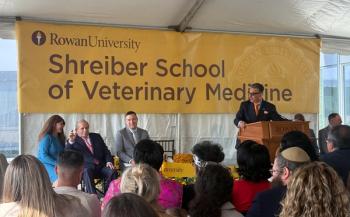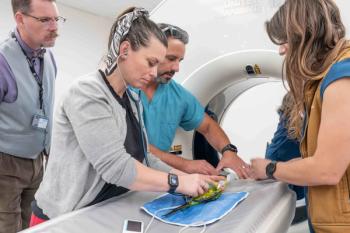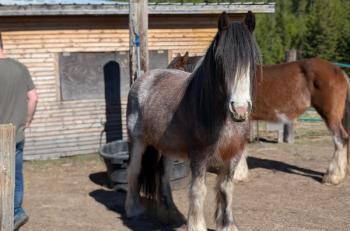
Arthrosonography: Joints of the back, pelvis and hind limb (Proceedings)
The soft tissue structures of the joints, back, and foot can be evaluated ultrasonographically yielding important diagnostic information that cannot be obtained radiographically.
Diagnostic ultrasonography has more recently been applied to the assessment of other less traditional musculoskeletal problems such as evaluation of bone, joints, muscle and nerves. The soft tissue structures of the joints, back, and foot can be evaluated ultrasonographically yielding important diagnostic information that cannot be obtained radiographically.
Normal Sonographic Anatomy of the Joints of the Hindlimb
Back
The supraspinous ligament is visible as an echoic band superficially, where its fibers are parallel to the skin and hypoechoic deeper due to the obliquity of the ligament near the interspinous spaces. The deeper portion of the supraspinous ligament is continuous with the interspinous ligament, which also appears hypoechoic. The more superficial portion is continuous with the thick echoic thoracolumbar fascia. The insertion of the supraspinal ligament onto the dorsal spinous process can be imaged.
The sacroiliac ligament has a dorsal portion that originates from the tuber sacrale and inserts on the tops of the dorsal spinous processes of the sacrum. The dorsal portion is a thick echoic structure that is partially covered by the gluteus medius muscle. It appears oval in transverse section and measures 6-10 mm in thickness. It also has a ventral portion that is a thick triangular sheet of ligamentous tissue that originates from the tuber sacrale and the caudomedial border of the ilial wing and inserts on the lateral sacral crest that is formed by the fused transverse processes. This ligament also appears echoic and is approximately 5 mm thick and 5 mm wide. The ventral sacroiliac ligament is attached to the ventral aspect of the articular surfaces, close to the joint. This ventral sacroiliac ligament blends ventrally and caudally with the sacrosciatic ligament.
Hip
The greater trochanter of the femur and the outer portion of the acetabulum can be imaged but the deeper portions of the hip joint are not visible sonographically. Transrectal sonographic evaluation of the pelvis can also be performed.
Stifle
The medial, middle and lateral patellar ligaments can be imaged in their entirety from origin to insertion. They are homogeneous echoic with a parallel fiber pattern. They vary in shape from a triangular medial patellar ligament to a round middle patellar ligament to a flattened and wide lateral patellar ligament. The proximal portion of the lateral patellar ligament extends over the lateral trochlear ridge of the femur. There is a large fat pad in the distal portion of the stifle separating the distal portion of the patellar ligaments from the synovial membrane. A small amount of joint fluid is usually imaged in the normal femoropatellar joint caudal to the medial patellar ligament and caudal to the lateral patellar ligament. Long and thick synovial villi are usually imaged in the medial recess of the femoropatellar joint.
The medial and lateral collateral ligaments extend from a recess in the distal femur to the proximal tibia. The medial collateral ligament is attached to the medial meniscus while the lateral collateral ligament is separated from its meniscus by the popliteal tendon. The medial and lateral meniscus both have a triangular radial section. Their attachment to the proximal tibia (cranial meniscotibial ligaments) can be imaged only in the flexed stifle. With flexion the insertion of the cranial cruciate onto the proximal tibia is imaged and the body of the caudal cruciate can also be imaged deep to the cranial cruciate ligament. From the caudal approach, the caudal attachments of the menisci are visible as are the cruciate ligaments. There is normally a small amount of fluid in the medial femorotibial joint that is located between the medial patellar ligament and the medial collateral ligament with little or no synovial villi visible. There is no synovial fluid normally imaged in the subextensorius recess of the lateral femorotibial joint.
The distal articular margins of the patella and the articular margins of the femorotibial joint are normally smooth and regular. The articular cartilage of the medial femoral trochlea is normally 1-2 mm thick while the lateral articular cartilage is 2-3 mm thick. The subchondral bone in the trochlear groove may appear irregular. With flexion, the distal articular margins of the femoral condyles can be imaged. With the caudal approach to the stifle joint, the caudal articular margins of the femoral condyles are visible.
Hock and Crus
The peroneous tertius tendon extends from the distal femur to insert on the proximal aspect of the MT3, the calcaneus and the third and fourth tarsal bones. It is located on the cranial aspect of the limb, lying between the tibialis cranialis and extensor digitorum longus muscles. Proximally, the peroneus tendon is roughly oval in shape and it flattens distally until it divides into two branches to insert laterally on the calcaneus and fourth tarsal bone and medially on the third tarsal bone and MT3. The tibialis cranialis muscle lies deep to the peroneus tertius and inserts in two branches on the proximal end of the metatarsal bone and, as the cunean tendon, on the first tarsal bone. The bifurcation of the tendon occurs immediately distal to the bifurcation of the peroneus tertius. There is a sheath at the point the tendon courses superficially between the branches of insertion of the peroneus tertius and a bursa beneath the cunean tendon. The superficial digital flexor muscle lies between the two heads of the gastrocnemius muscle. Its tendon spirals around the tendon of the gastrocnemius to adopt a superficial location within the common calcaneal tendon. It has an insertion on the tuber calcis and then courses distally over the point of the hock. The tendon is echoic and has an oval shape, except at the point of the hock where it is flattened and crescent shaped. The gastrocnemius tendon arises from the lateral and medial heads of the gastrocnemius muscle that are superficial in location. In its mid portion, the tendon spirals around the SDFT so that it lies deep to the SDFT. It inserts on the calcaneal tuberosity. Longitudinal and transverse images are made from the plantar aspect of the limb. The tendon is uniformly echoic with an oval shape on transverse images. The gastrocnemius bursa is dorsal to the insertion of the gastrocnemius tendon on the calcaneal tuberosity. The calcaneal bursa is a large bursa lying deep to the SDFT, from the distal fourth of the tibia to the middle of the tarsus. It is visible between the superficial digital flexor and gastrocnemius tendons. The tarsal sheath can be imaged surrounding the DDFT along the medial aspect of the hock and in the proximal metatarsal region. The tarsal sheath is also a thin echogenic structure that is difficult to distinguish from the DDFT unless there is fluid contained within the sheath.
The collateral ligaments are multiple; there are one long and 3 short lateral and medial collateral ligaments. The long lateral collateral ligament originates on the lateral malleolus of the tibia and inserts on the distolateral calcaneus, fourth tarsal bone, MT4 and MT3. The 3 short lateral collateral ligaments are partially fused at their origin dorsal to the groove for the lateral digital extensor tendon on the lateral malleolus of the tibia. The superficial short lateral collateral ligament inserts on the calcaneus and tibial tarsal bone just distal to the coranoid process of the calcaneus. The middle short lateral collateral ligament inserts on the tibial tarsal bone dorsal to the superficial lateral collateral ligament. The deep short lateral collateral ligament inserts more dorsally on the tibial tarsal bone approaching its lateral margins. The long medial collateral ligament originates on the medial malleolus of the tibia and extends distally to its insertion on the distal tibial tuberosity of the tibial tarsal bone, the medial surface of the small tarsal bones and the proximal portion of MT2 and MT3. The 3 short medial collateral ligaments extend from the craniomedial aspect of the medial malleolus of the tibia under the long collateral ligament to their insertions. The flat short medial collateral ligament inserts on the proximal and distal tuberosity of the tibial tarsal bone, part of that is immediately adjacent to the attachment of the long collateral ligament. The round short medial collateral ligament inserts on the distomedial aspect of the sustentaculum tali and the plantaromedial aspect of the central tarsal bone. The short flat deep collateral ligament inserts on the tibial tarsal bone.
The articular capsule is easily imaged in the dorsomedial compartment of the tarsocrual joint. There is a large dorsomedial recess that is imaged just below the medial malleolus of the tibia. There is minimal synovial fluid imaged in the dorsomedial compartment of the tarsocrual joint with distinct synovial villi floating within the fluid. Little fluid is normally imaged in the plantaromedial or plantarolateral compartments of the joint. The articular cartilage of the dorsal aspect of the talus is readily visualized, enabling the medial and lateral trochlear ridges to be evaluated ultrasonographically. With flexion of the hock, the caudoproximal portion of the trochela of the talus can also be imaged. Minimal synovial fluid is imaged in the distal intertarsal joint along its medial aspect or in the tarsometatarsal joint along its plantarolateral aspect. There should be clean distinct articular margins visible of these 2 joints with an anechoic space detected representing the joint.
Abnormal Ultrasonographic Appearance of Joints
Synovitis
The normal joint fluid is anechoic or sonolucent with the joint lined by a thin synovial membrane and surrounded by a thicker echoic joint capsule. Synovial villa or fronds can be imaged protruding into the joint space. Marked thickening of the synovial lining can be seen in horses with chronic proliferative synovitis and villonodular lesions in the synovia can be imaged as echogenic synovial masses. In one study of horses with lameness referable to the fetlock joint, hypoechoic areas were identified in the joint capsule of 36% of horses and synovial membrane thickening in 19%. Fracture fragments were imaged in 12% of the horses in this study with abnormal dorsal articular margins in 17%. Flocculent, hypoechoic to echogenic fluid may be imaged in septic arthritis. A hemarthrosis is suggested by the presence of large quantities of uniformly echoic fluid, particularly in horses with periarticular hematomas. Synovial fistulae (ruptures of the joint capsule) can be located ultrasonographically, as can periarticular fluid accumulations. Defects in the articular cartilage may also be imaged as scooped out areas or irregularities along the surface prompting further investigation. OCD lesions or fracture fragments may be imaged sonographically within the joint space. Fractures can also be diagnosed sonographically that are suspected clinically or scintigraphically but are not detected radiographically (routine radiographs). The articular or nonarticular nature of fracture fragments can be determined sonographically.
Collateral Ligament Desmitis and Joint Injuries in the Hindlimb
Sacroiliac Joint
Ultrasound-guided injections of the sacroiliac area can be performed in horses by inserting the needle into the gluteus medius muscle along a transverse line joining the cranial aspect of both left and right tuber coxae. The needle, once it is imaged, is then directed just below and parallel to the iliac wing in a cranioventral direction until contact with the transverse process of the sacrum is achieved and then the injection proceeds.
Hip
The greater trochanter of the femur and the outer portion of the acetabulum can be imaged and fractures of the greater trochanter and acetabulum have been diagnosed sonographically. Subluxation of the coxofemoral joint can be diagnosed by detecting obvious dorsal displacement of the femoral head relative to the acetabulum during weight bearing views. Joint effusion and associated acetabular fractures can also be diagnosed. Rectal ultrasound examination of the pelvis is also useful in the diagnosis of fractures involving the hip.
Stifle
Patellar ligament desmitis is most common in horses with a prior patellar ligament desmotomy. Spontaneous injury often involves the middle patellar ligament and is usually a discrete area of fiber tearing (core lesion) within this ligament. Injuries to the collateral ligaments of the femorotibial joint are more common, with or without associated meniscal damage. Injuries to the medial collateral ligament may be associated with the triad of injuries commonly seen in stifle injuries; injury to the medial collateral ligament, medial meniscus and cranial cruciate ligament. Injury to the collateral ligaments is usually associated with a diffuse area of fiber damage rather than a discrete core lesion. Bony irregularities (enthesophyte formation) at the origin or insertion of the collateral ligaments are also frequently detected ultrasonographically. Avulsion fractures of the origin or insertion of the collateral ligaments can also be detected in association with a collateral ligament desmitis. Meniscal damage is detected when the meniscus has changes in its size, shape echogenicity or position relative to the femoral condyles and proximal tibia. Collapse of the joint space may also be appreciated in horses with meniscal damage. Femorotibial joint effusion often accompanies collateral ligament desmitis and meniscal injury. Cruciate ligament desmitis is uncommon but similar changes in echogenicity, fiber alignment and cross-sectional area of the cruciate ligaments occur with injury. Bony changes associated with the insertion of the cranial cruciate on the proximal tibia are detectable ultrasonographically but only with the stifle flexed during the examination.
Hock
Collateral ligament desmitis appears to be less common here than in the stifle or fetlock joints. The affected collateral ligament is usually enlarged and hypoechoic, lacking a parallel fiber pattern. Periligamentous soft tissue swelling is common. Enthesophyte formation at the origin or insertion of the collateral ligaments is common. Fractures of the lateral malleolus of the tibia involve the lateral collateral ligaments and are usually associated with trauma.
Fetlock
Collateral ligament injuries are more common in the fetlock joint than previously recognized and may occur more frequently in the lateral collateral ligament of the metatarsophalangeal joint. The affected collateral ligaments are enlarged, hypoechoic and usually demonstrate a diffuse area of fiber damage. Avulsion fractures of the origin or insertion of these collateral ligaments have been detected. Periarticular soft tissue swelling is usually present in these horses. Collateral ligament desmopathy was identified ultrasonographically in 21% of horses with lameness localized to the fetlock joint region in one study. Villonodular synovitis is also frequently diagnosed ultrasonographically by measuring the thickness of the dorsal synovial plica. The proximal synovial fold of the metacarpo-metatarsophalangeal joint should not exceed 2 mm in thickness.
Pastern
Collateral ligament desmitis and desmitis of the palmar/plantar ligaments of the proximal interphalangeal joint have been demonstrated ultrasonographically. The collateral ligaments or palmar/plantar ligaments are enlarged, hypoechoic and lack the normal parallel fiber pattern. Avulsion fractures associated with the origins or insertions of these ligaments have been detected, but most frequently involve the insertions of the palmar/plantar ligaments of the proximal interphalangeal joint as the palmar/plantar eminences of P1 are usually affected. Desmitis of the palmar/plantar ligaments of the proximal interphalangeal joints have been reported and have been reported alone and in association with injuries to the superficial digital flexor tendon and distal sesamoidean ligaments.
Newsletter
From exam room tips to practice management insights, get trusted veterinary news delivered straight to your inbox—subscribe to dvm360.






